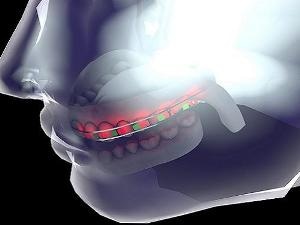Oct 26 2017
Smart 3D-printed braces with flexible, nontoxic batteries and lights could cut the time and costs involved in straightening and realigning teeth.
 Flexible lithium batteries have been incorporated into dental braces as part of efforts to increase the efficiency of corrective orthodontics. Credit: © 2017 KAUST
Flexible lithium batteries have been incorporated into dental braces as part of efforts to increase the efficiency of corrective orthodontics. Credit: © 2017 KAUST
This semitransparent, 3D-printed dental brace has two near-infrared light-emitting diodes (LEDs) and one lithium-ion battery on every tooth. The Researchers at KAUST have developed this innovative orthodontic system.
The batteries give sufficient energy to switch these LEDs on and off, depending on how they are programmed by a Dentist, to deliver localized light therapy according to the needs of each tooth. Phototherapy augments bone regeneration and lessens the time and costs involved in corrective orthodontics. The brace can be removed for the batteries to be recharged.
"We started embedding flexible LEDs inside 3D-printed braces, but they needed a reliable power supply," explains Muhammad Hussain who led the study along with Arwa Kutbee, a PhD student. "After the incidents with the Samsung Galaxy 7 batteries exploding, we realized that traditional batteries in their current form and encapsulation don't serve our purpose. So we redesigned the state-of-the-art lithium-ion battery technology into a flexible battery, followed by biosafe encapsulation within the braces to make a smart dental brace."
Researchers have redesigned the batteries using a dry-etching technique, which removes the silicon substrate usually found on its back. This process resulted in the thinning of the battery to 2.25 mm x 1.7 mm, making it flexible. Tests revealed that the volumetric energy—the ratio of energy to device size—of the redesigned batteries continued to remain high even after many cycles of continuous operation.
The batteries were then encapsulated in biocompatible soft polymeric materials in order to prevent the possibility of leakage, thus making them safe to be placed in the mouth. When human embryonic kidney cells were cultured on these batteries for several days, they thrived and multiplied. This proved as a testament to their biocompatibility. The batteries' electrochemical performance increased linearly with rising temperature, up to 90 °C, making them stable.
Hussain stated that this orthodontic system is a preliminary prototype, "which is more than a proof of concept." The next step is to conduct clinical trials to test this new product, Hussain said.